February 15, 1927
San Pedro
It’s a mysterious case indeed that enmeshes Mr. Alvin Hyder, wealthy inventor of diesel engines and proprietor of the motorship Nora, working the Channel Islands trade, and his daughter Nora Thomas, 22, wife of a local grocery man.
Seems that Nora went into her father’s room at 2315 South Grand Avenue and shot daddy in the head with a .38, before creeping back to her home at 2224 South Grand. Hard-headed Alvin did not die, but repelled the bullet with the force of his personality, sending the leaden lump on a one way trip off his cheekbone, around his face and into the back of his neck, where it remained. Following treatment at San Pedro Emergency Hospital, Alvin returned to Grand Avenue to reflect upon all that had brought him to such a place.
Nora, meanwhile, was arrested and charged with attempted murder. She pled not guilty, with local tongues wagging that this was really all about Nora’s baby who had died, or maybe $10,000 of her father’s money that she thought ought be hers.
But in May, the girl was released after the DA declared he had insufficient evidence to convict. Perhaps dad and daughter reconciled in time to take advantage of the Cabrillo Beach grunion run, the dates for which were published in today’s papers. It’s the least a captain can do for his ship’s namesake.
[update, July 2008: A descendent of the Hyder family kindly emailed with some additional information to add to this rather mysterious tale. We are always so appreciative when folks with personal knowledge write in to share it.
"Alvin was washed overboard off of his fishing boat the Nora II about 1936. A large sneaker wave overturned the boat off of San Nicolas Island. The Coast Guard responded, but his body never turned up. He was 56. His children Nora, Buster, and Alva are all gone now. Nora passed away at age 91 in 1995. She did not discuss her reasons for shooting her father until her 80s. Buster died in ’94 at age 87. Alva died in ’98 at age 73. In 1993, a book was published by the Santa Cruz Island foundation, edited by Marla Daily, entitled "Occasional Paper Number 6." She interviewed Buster about our family homesteading on Santa Barbara Island from 1914 to 1929. The National Park Service built a little museum onto the ranger house out there. In 1993, the TV program "California’s Gold" did a half hour program on our family reunion and the opening of the little museum. We had 3 generations there. So, there is a little update to your newspaper clipping."]

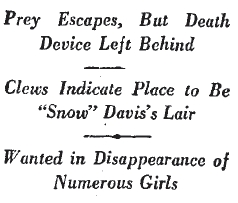 The headline read, "TORTURE DEN AND POISON PEN OF SUSPECTED DOPE SLAYER BELIEVED FOUND," and the story itself contained six missing girls, a basement torture chamber, and a "trick" pencil that could turn into hypodermic needle, chock full of poison, with the flick of a finger.
The headline read, "TORTURE DEN AND POISON PEN OF SUSPECTED DOPE SLAYER BELIEVED FOUND," and the story itself contained six missing girls, a basement torture chamber, and a "trick" pencil that could turn into hypodermic needle, chock full of poison, with the flick of a finger.
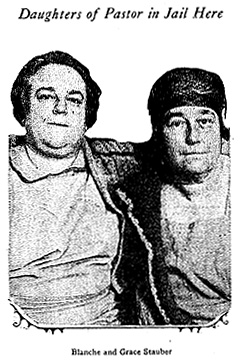


 Mr. and Mrs. Hugh Fillmore will not be among the celebrants. Margaret Fillmore has filed for a divorce. Their love has turned as cold as a stone floor.
Mr. and Mrs. Hugh Fillmore will not be among the celebrants. Margaret Fillmore has filed for a divorce. Their love has turned as cold as a stone floor. 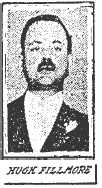 Hugh was thinking only of the advertising potential of having the tile in his home, especially since his sister-in-law was the actress
Hugh was thinking only of the advertising potential of having the tile in his home, especially since his sister-in-law was the actress 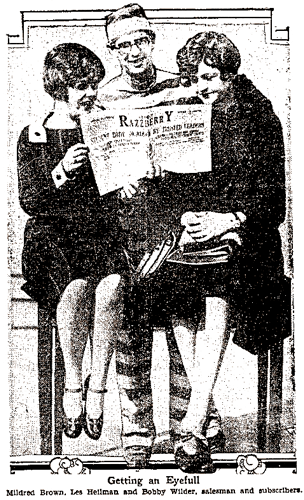
 February 10, 1927
February 10, 1927
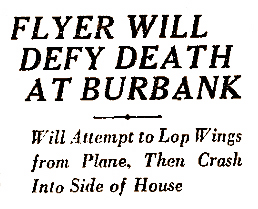 Sure, while we’ve
Sure, while we’ve 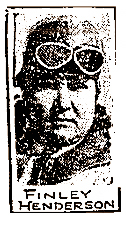 For the record, when the stunt was performed on February 20, Finley emerged unscathed, smoking a cigarette. And then noted for the wowed crowd and boys of the press “The stunt is easy if you know how to do it.”
For the record, when the stunt was performed on February 20, Finley emerged unscathed, smoking a cigarette. And then noted for the wowed crowd and boys of the press “The stunt is easy if you know how to do it.”
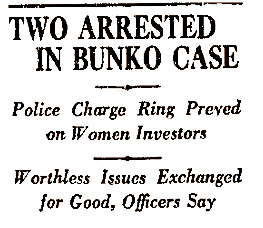 It’s a pretty simple scheme.
It’s a pretty simple scheme. 
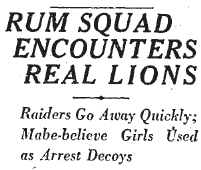 Over the weekend, the District Attorney’s crackerjack Prohibition task force proved beyond the shadow of a doubt their devotion to the cause.
Over the weekend, the District Attorney’s crackerjack Prohibition task force proved beyond the shadow of a doubt their devotion to the cause.